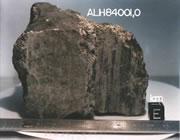 Bacteria carried on a meteorite would experience around a million times atmospheric pressure if they crashed into Earth.© NASA
Bacteria carried on a meteorite would experience around a million times atmospheric pressure if they crashed into Earth.© NASABacteria could survive crash-landing on other planets, a British team has found. The result supports to the idea that Martian organisms could have fallen to Earth in meteorites and seeded life.
Bugs inside lumps of rock can survive impacts at speeds of more than 11 kilometres per second, say the researchers 1. The work also shows that bacteria could survive crashing into icy surfaces such as Jupiter's moons Europa and Ganymede.
“A few years ago everyone said we were crazy”
Mark Burchell
University of Kent at Canterbury
The possibility that Earth's first life came here inside space rocks - the panspermia hypothesis - was proposed in 1903 by the Swedish chemist Svante Arrhenius. But the painful landing has always been a stumbling block.
Mark Burchell and his colleagues at the University of Kent, Canterbury, have put panspermia to the test by firing lumps of porous ceramic infiltrated with bacteria into targets. During impact, the bacteria are crushed by up to a million times atmospheric pressure.
"A few years ago everyone said we were crazy," says Burchell. "They knew it wouldn't work." But in 2001 he and his colleagues showed that soil bacteria can survive a high-speed impact into soft gel2. Most of the microbes died, but enough survived to make panspermia possible, provided that the bugs don't have to travel too far: they would probably be sterilized by cosmic rays and UV radiation during a journey from another solar system.
Crushing blow
But the researchers didn't know whether the pressures generated in their experiment were comparable to those of a meteorite impact. Nor did they know how different microbial species would fare.
To find out, the team used a gas-powered gun to fire bits of ceramic, between 0.1 and 2 millimetres across, into targets of gel or ice. The projectiles were loaded with cells or spores of the soil bacteria Rhodococcus erythropolis or Bacillus subtilis.
 Argument still rages over whether this meteorite contains fossilized martian bacteria. But could meteorites also transport live organisms?© NASA
Argument still rages over whether this meteorite contains fossilized martian bacteria. But could meteorites also transport live organisms?© NASAAt similar pressures to those that would be suffered inside a meteorite as it crashed, around one in every ten million R. erythropolis cells and a few in every hundred thousand B. subtilis survived when they hit the gel. A gram of terrestrial soil typically contains a billion bacterial cells.
The survival rate for an ice target was about ten times higher, so Burchell and colleagues think that it's not just Earth and Mars that could have swapped life. The icy moons of Jupiter, for instance, at least one of which, Europa, has a sub-surface ocean of water, could seed one another. Or a planet could re-seed itself if, as some have suggested might have happened on the early Earth, a massive impact wiped out all life.
University of Kent at Canterbury
